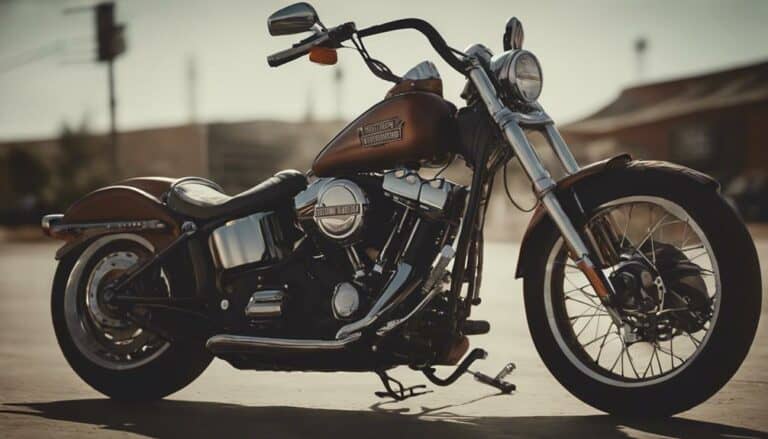When you glance at a lineup of Harley Davidson motorcycles, do you find yourself wondering how to distinguish one from another? The task may seem daunting at first, but fear not, for there are key characteristics that can help you decipher the various models with ease.
From the iconic design elements to the subtle nuances in engine types, understanding these distinctions will not only deepen your appreciation for Harley Davidson motorcycles but also equip you with the knowledge to differentiate between them effortlessly.
Key Takeaways
- Recognize engine types like Knucklehead, Panhead, Shovelhead, and Evolution for model differentiation.
- Identify unique features of each engine, such as nose cones, cam plates, and rocker boxes.
- Understand the evolution of engine technology and performance from Flathead to Twin Cam models.
- Distinguish design elements in Classic Big Twin models like flatheads, overhead valves, and pushrod-operated valves.
Early Harley-Davidson Model Evolution
Early in the evolution of Harley-Davidson models, the transition from the iconic Flathead engine to the Knucklehead marked a distinctive change in design and recognition features. The Flathead engine, with its vertical fins instead of a Rocker Box, gave way to the Knucklehead model, easily identifiable by its protruding balls resembling knuckles.
Following the Knucklehead, the Panhead engines emerged, showcasing a Rocker Box design resembling an upside-down pan and larger rocker arm bolts. Subsequently, Shovelhead engines took the stage, known for their Rocker Box design resembling an upside-down shovel and their unique performance sound.
These transitions not only altered the appearance of Harley-Davidson models but also brought about advancements in engine technology and performance. The progression from the Flathead to the Knucklehead, Panhead, and Shovelhead models laid the foundation for the innovative engines that followed, each contributing to the rich legacy and distinct identity of Harley-Davidson motorcycles.
Decoding Current Harley Model Designations
Deciphering the intricate system of current Harley model designations reveals a wealth of information about each bike's unique characteristics and features. Harley-Davidson utilizes various letter combinations to differentiate between its models. Below is a breakdown of some common model names and their designations:
| Model Name | Designation | Characteristics |
|---|---|---|
| Sportsters | XL | Four cams with parallel pushrods |
| Touring bikes | FL, FLH | Batwing or sharknose fairings |
| Softails | FXR | Rubber-mounted Big Twins frame |
| Dyna | EL | Glide frame designation |
| Road King | FLHT | Touring frame designation |
Understanding these designations can help you identify the type of Harley you are looking at and provide insight into its specific features. Whether it's a Twin Cam engine or a Glide frame, decoding Harley's model names can enhance your appreciation for the diverse range of motorcycles they offer.
Understanding Harley Engine Types
To further enhance your understanding of Harley-Davidson motorcycles, let's now explore the intricacies of different Harley engine types. Harley engines have unique characteristics that set them apart.
Panhead engines, for instance, are easily recognizable by their distinctive top Rocker Box, resembling an upside-down pan. Shovelhead engines, known for their performance and distinctive sound, have a Rocker Box shape resembling an upside-down shovel.
Moving on, Evolution (Evo) and Twin Cam engines present further distinctions. Evo engines are characterized by their cam plate design, while Twin Cam engines can be identified by the number of cams they possess. These details offer valuable insights into the world of Harley engines, allowing enthusiasts to differentiate between models accurately.
Understanding these engine types not only aids in identification but also enhances your appreciation for the craftsmanship and innovation that Harley-Davidson brings to its motorcycles.
Identifying Classic Big Twin Models
Classic Big Twin models, such as the Knucklehead, Panhead, Shovelhead, Evolution (Evo), and Twin Cam, can be readily distinguished by unique features within their engine designs. The Knucklehead stands out with its distinctive protruding balls resembling knuckles, while the Panhead's top Rocker Box resembling an upside-down pan aids in its recognition.
Shovelhead engines are known for their Rocker Box that resembles an upside-down shovel, contributing to their unique performance and sound. Differentiating between Evolution (Evo) and Twin Cam models can be done by examining their nose cone designs and cam plate variations. Twin Cam models feature two cams, while Evo models have aluminum rocker boxes.
Exploring Special Edition and Custom Models
When examining Harley-Davidson models, it's intriguing to explore the realm of Special Edition and Custom bikes, which showcase unique features and personalized touches setting them apart from standard offerings. Here's a breakdown to help you understand these distinctive models better:
- Special Editions:
Special Edition Harley-Davidson models, such as the Super Glide and Road Kings, often boast unique paint schemes, badges, and accessories, making them stand out in a crowd.
- Customization:
Custom Harley-Davidson bikes, like the Wide Glide, are easily recognizable by their aftermarket parts, personalized modifications, and one-of-a-kind design elements tailored to suit the owner's preferences.
- Limited Production:
Limited production runs of special edition models, such as the Harley-Davidson CVO lineup, offer exclusive features and higher levels of customization, catering to those seeking something truly unique.
- Unique Touches:
Custom Harley-Davidson models frequently showcase custom paint jobs, specialty exhaust systems, upgraded performance components, and unique styling cues, reflecting the owner's individuality and style.
Conclusion
As you navigate the world of Harley-Davidson models, remember that like different flavors of ice cream, each one has its own unique taste and appeal.
Just as you wouldn't mistake vanilla for chocolate, enthusiasts appreciate the distinct characteristics that set each Harley model apart.
So next time you see a Harley on the road, take a moment to appreciate the craftsmanship and individuality that make each one special.
Happy riding!

